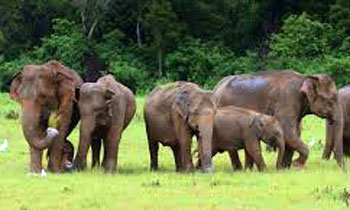
Japanese consortium to invest US $ 15mn in solar power plant
From left: Tokyo Kyodo Accounting Director Yoshikazu Noda, Shibatasyoji Co. Limited Director Tatsuhiro Shibata, Sawada Co. Director Hiroki Sawada, TAD Lanka Investments Director Atheeq Ansar, WQ Inc. Director Steffen Studeny, Sierra Holdings Director Frank Irugalbandara and Tokyo Kyodo Accounting Partner Ryutaro Uchiyama at the official signing ceremony.
A US $ 15 million project for the establishment of a solar power plant in Sri Lanka is underway with investments from three Japanese companies through a Japanese consortium.
The three companies—Shibatasyoji Co. Ltd, Sawada Co. Ltd and WQ Inc.—are renowned for their extensive expertise in establishing solar power plants in Japan. Shibatasyoji Co. Ltd and Sawada Co. Ltd are the main investors while WQ Inc. will be providing the main components to the project.
The Japanese experts have conducted a series of extensive research in this field, concluding that Sri Lanka is one of the most viable countries for solar power. In addition, the Sri Lankan government’s announcement in 2015 vesting its interest to establish a series of solar power plants in the country gave it the needed boost in laying the groundwork for this project.
The project is in partnership with TAD Lanka Investments (TAD), the local facilitating partner for the project, and Sierra Technology Holdings, a subsidiary company of Sierra Holdings, the local EPC partner for the project.
The official signing ceremony took place on February 3 between the Japanese consortium and the two local entities with the initial commitment of establishing a 10 MW solar power plant with an investment of US $ 10 million and an added pledge to invest US $ 150 million in 100 MW solar power plant in the future.
The decision for the pledge will depend on the success on this primary effort, which will be monitored closely. The target is to establish the project within a maximum time frame of 18 months, which depends entirely on the Sri Lankan government’s willingness to issue Standard Power Purchase Agreements to potential investors.
“This project will set the benchmark for future projects of this calibre in Sri Lanka paving the way to meet the impending power crisis and we are willing to give our unstinted support towards reaching success in this field,” remarked a representative of the Japanese consortium.
“TAD Lanka Investments is proud to be involved in this gigantic venture, which provides the country with stability and certain growth in the technology that promotes the usage of sustainable and renewable energy. It also addresses the crisis at hand, while opening variable opportunities for further investment to Sri Lanka in this area,” commented TAD Director/CEO Atheeq Ansar. TAD was founded in May 2016 for the main purpose of streamlining and safeguarding all types of foreign investments and investors channelled to Sri Lanka.
During its brief period of operation, TAD has in effect successfully streamlined many significant investments and continues to gain a reputation as a top-notch company among its ever-growing clientele.
This project is a welcome effort as experts predict Sri Lanka is to face a power crisis in 2018 due to the inability to cope with the high demand for power. Such projects are of vital importance to improving the stability and infrastructure of the country.
With the government focusing on securing more foreign direct investments to the country, encouraging such projects will benefit Sri Lanka in the long term and encourage more investors to follow suit. Therefore, the importance of this project and the pledge to invest more solely depends on the success of this premier project.
Source,07/02/2017,Dailymirror – See more at: http://www.dailymirror.lk/article/Japanese-consortium-to-invest-US-mn-in-solar-power-plant–123372.html#sthash.ar2MNpqa.dpuf

Sea wave electricity soon: Minister
The Power and Renewable Energy Ministry today said the Finnish Ambassador to Sri Lanka Rauli Suikkanen had agreed to provide the latest technology to generate electricity from sea waves to the country. He expressed this at a special discussion with Minister Ranjith Siyambalapitiya at the Ministry. “Our country is surrounded with sea and therefore we can generate electricity using sea waves easily. We can determine the capacity of electricity which can be generated. The projects can be launched with the latest technology with minimal cost. Therefore the electricity can be used during the dry seasons,” the minister said. (Chaturanga Pradeep) Source-08/02/2017,Dailymirror, See more
Source-07/02/2017,Dailymirror, See more at: http://www.dailymirror.lk/article/Sea-wave-electricity-soon-Minister-123443.html#sthash.oTnuSLqO.dpuf

Wild Elephant Management Zone is a joke
Wildlife conservation officers are concerned about the on going clearing of the jungle in the Hambantota wildlife zone without declaring the boundaries of the proposed Wild Elephant Management Zone. They said more than 400 wild elephants had lost their natural habitats making them to roam into human habitats. They pointed out that this alarming situation aggravated the human elephant conflict. Chairman of the Wildlife Conservation Research Institute Dr. Prutuvi Raj Fernando said the only way to prevent this situation was to declare the proposed Wildlife Management Zone but it had been dragging on for years. He said the relevant authorities were reluctant to implement it and that over 50 per cent of the proposed forest reserve had been cleared. (Santha Gamage) See more
Source- 7/02/2017,Daily Mirror/ See more at: http://www.dailymirror.lk/article/Wild-Elephant-Management-Zone-is-a-joke-123416.html#sthash.rLAP6YC0.dpuf

Environmental Protection And Sustainable Development In Sri Lanka
There can be no economy when there is no efficiency
-Benjamin Disraeli-Letters
This column dedicated to the notion of fulfilling the aspirations of Sri Lankan society turns its spotlight on the protection of the environment in Sri Lanka while engaging in sustainable development that will fulfill the aspirations of all Sri Lankans thereby ensuring preservation of the environment in our land.
 Environmental concerns in Sri Lanka include deforestation; soil erosion; wildlife populations threatened by poaching and urbanization; coastal degradation from mining activities and increased pollution; freshwater resources being polluted by industrial waste and sewage runoff; waste disposal; and air pollution in Colombo and other cities due to emissions from motor vehicles and factories and other industrial establishments.
Environmental concerns in Sri Lanka include deforestation; soil erosion; wildlife populations threatened by poaching and urbanization; coastal degradation from mining activities and increased pollution; freshwater resources being polluted by industrial waste and sewage runoff; waste disposal; and air pollution in Colombo and other cities due to emissions from motor vehicles and factories and other industrial establishments.
The forests in Sri Lanka have been removed to make way for agricultural land and plantations and to provide fuel and timber. The sale of timber is a part of the national economy to raise revenue. The country is a major producer of tea and the land required for tea plantations is substantial. Population pressure is also a significant factor as is the removal of forested areas to make way for irrigation networks which were a major process in the 1980s. Apart from the environmental implications deforestation in Sri Lanka has caused ill effects such as flooding, landslides and soil erosion from exposure of the deforested areas. It is also the primary threat to the survival of Sri Lanka’s biodiversity. Sri Lanka has 751 known species of amphibians, birds, mammals and reptiles of which 21.7 percent are endemic, and over 3314 species of vascular plants, of which 26.9 percent are endemic.
One of the main threats to the sustainability of Sri Lanka’s forests is government development policies in relation to the demand for timber and fuel and also the need to create plantations to raise revenue. Government policies are focused primarily on timber production and tree plantations. The Sri Lankan government working in conjunction with multi-national institutions has seen a major change in timber harvesting in Sri Lanka for the cause of sustainable development. Commercial plantations have gradually been brought under management system in Sri Lanka to produce wood in an economically efficient and sustainable way.
The harvesting, processing and the sale of wood products from state forests is conducted by the state owned State Timber Corporation. In the 1980s the cause progressed significantly with the Asian Development Bank (ADB) funding the Community Forestry Project (CFP) which concentrated on the development of fuelwood plantations and agro-forestry in 5 of the 25 districts of Sri Lanka. While illegal logging in Sri Lanka is not a major problem as it is in many countries, deforestation has still affected the lives of every day people in some parts of Sri Lanka where removal of forests has resulted in greater time and energy being spent gathering firewood typically by women who have to travel relatively long distances, affecting their health and well-being. Deforestation is one of the most serious environmental issues in Sri Lanka. In the 1920s, the island had a 49 percent forest cover but by 2005 this had fallen by approximately 20 percent. Between 1990 and 2000, Sri Lanka lost an average of 26,800 hectares of forests per year. This amounts to 1.14 percent of average annual deforestation rate. Between 2000 and 2005 the rate accelerated to 1.43 percent per annum.
However with a long history of policy and laws towards environmental protection, deforestation rates of primary cover have actually decreased to 35 percent since the end of the 1990s due to a strong history of conservation measures. The problem of deforestation in Sri Lanka is not as significant in the southern mountainous regions as it is in northern Sri Lanka, largely due to the nature of environmental protection.
The government and international environmental organizations have taken several steps to address the problem over the years, establishing national parks, reserves and sanctuaries, which now cover as much as 15 percent of the island’s total area as at 2007. The Sinharaja Forest Reserve, which was established in 1978 to protect the nearly extinct tropical lowland rain forest, was flagged as a World Heritage Site in 1988.
The history of environmental policy and law in Sri Lanka however goes back much further in history. In 1848, the Timber Ordinance No. 24 was signed for the reservation of forests, largely for timber production. In 1873, Hooker advocated the protection of natural forests above 5000 feet as climatic reserves and in 1938 a law was passed prohibiting the removal of forest above 5000 feet. In 1885, the Forest Ordinance No. 10 for the Conservation of Forests saw some protection of forests primarily for sustainable wood production but also some protection of wildlife in sanctuaries.
This was developed further in 1907 with Forest Ordinance No. 16 with some protection of forests and their products in reserved forests and village forests, again for the controlled exploitation of timber. In 1929 the first authoritative forest policy statement was given in regard to species protection and in 1937 the Fauna and Flora Protection Ordinance No. 2 was signed with the intention of protecting the wildlife in national reserves. However this was restricted to wild life in sanctuaries, and such habitats were protected only on state land, with complete freedom to exploit privately owned land. The Amendment Act No. 44 in 1964 saw the nature reserves and jungle corridors formally recognized as categories of Sri Lanka’s protected areas of national reserve.
In 1990, the National Policy for Wildlife Conservation was approved by the Sri Lankan cabinet with the prime objectives of sustaining the ecosystems and ecological processes and the preservation of genetic diversity. The government also introduced a logging ban that was implemented in all natural forests in Sri Lanka under the Forestry Sector Development Programme. In 1993 Amendment Act No. 49 also added Refuge, Marine Reserves and Buffer Zones as additional formal categories to the definition of the national reserve. Any degradation of the forest resource in Sri Lanka is dynamically related to the increasing demand for timber and fuel wood. Central to the sustainability of the forests of Sri Lanka in the future is the rate of population pressure and economic growth Not only will a growing population demand more fuel, they will also place a higher demand for housing construction materials with wood ,
Interference with nature results in disastrous effects. Several forest fires were reported during the past few weeks. The indiscriminate dumping of garbage in cities especially in Colombo has led to the spread of diseases. Colossal waste of public funds to purchase a luxury limousine for the use of the Mayor of Colombo was reported recently. These funds could have been used to purchase machinery for garbage conversion into manure. The Mayor has been reported saying that as Cabinet Ministers are using expensive limousines that he too is entitled to use such a vehicle. What service have these public officials and Ministers rendered to the people of Colombo or Sri Lanka to engage in such wasteful expenditure of public funds? Before demanding comforts these persons must render valuable service to the people.
The colossal waste of funds spent for the Anuradhapura Deyata Kirula Exhibition replete with many performances could have been used to provide a water purification plant for the people of Anuradhapura and suburbs who are dying of kidney ailments due to the intake of heavy metals in the dirty water they are forced to consume. Before beautifying cities and building road networks the basic needs of the people such as food, clean drinking water, adequate supplies of medicines in hospitals and other essentials for the sustenance of life of the citizens must be provided.
The abominable wasteful expenditure of public funds should be terminated forthwith for the welfare of the country. The President who has stated on several occasions that he holds power as a public trustee has advised public officials to make the best use of public funds. Addressing the Matale District Development Committee Meeting last week the President said that, ‘Everyone is duty bound to make the utmost contribution to society and the country. Similarly, public funds should be utilized carefully for the betterment of the country to gain maximum returns and productivity’(Daily News 3rd July 2012 pp.1and 8). Excellent advice indeed but whether the public officers follow such advice in practice appears to be doubtful. While an electrical energy or power crisis is looming in the near future with the water levels decreasing in the catchment areas the public institutions and commercial establishments seem to be switching on all billboards and illuminating their showrooms wasting valuable electrical energy late into the night in the city of Colombo.
As usual let me conclude with an amusing anecdote. The teacher asked the class to write an essay on what they would do if they had a million dollars. But, little Johnny handed in a blank paper. The teacher asked, ‘Johnny you have done nothing why?’ ‘Because,’ he replied ‘that is exactly what I’d do if I had a Million Dollars’.
We as Sri Lankans may now understand the reason why corrupt politicians and public officials do nothing for the motherland but relax and enjoy their existence wasting public funds.
May all celestial beings protect our motherland.
http://www.thesundayleader.lk/2012/07/08/environmental-protection-and-sustainable-development-in-sri-lanka/






